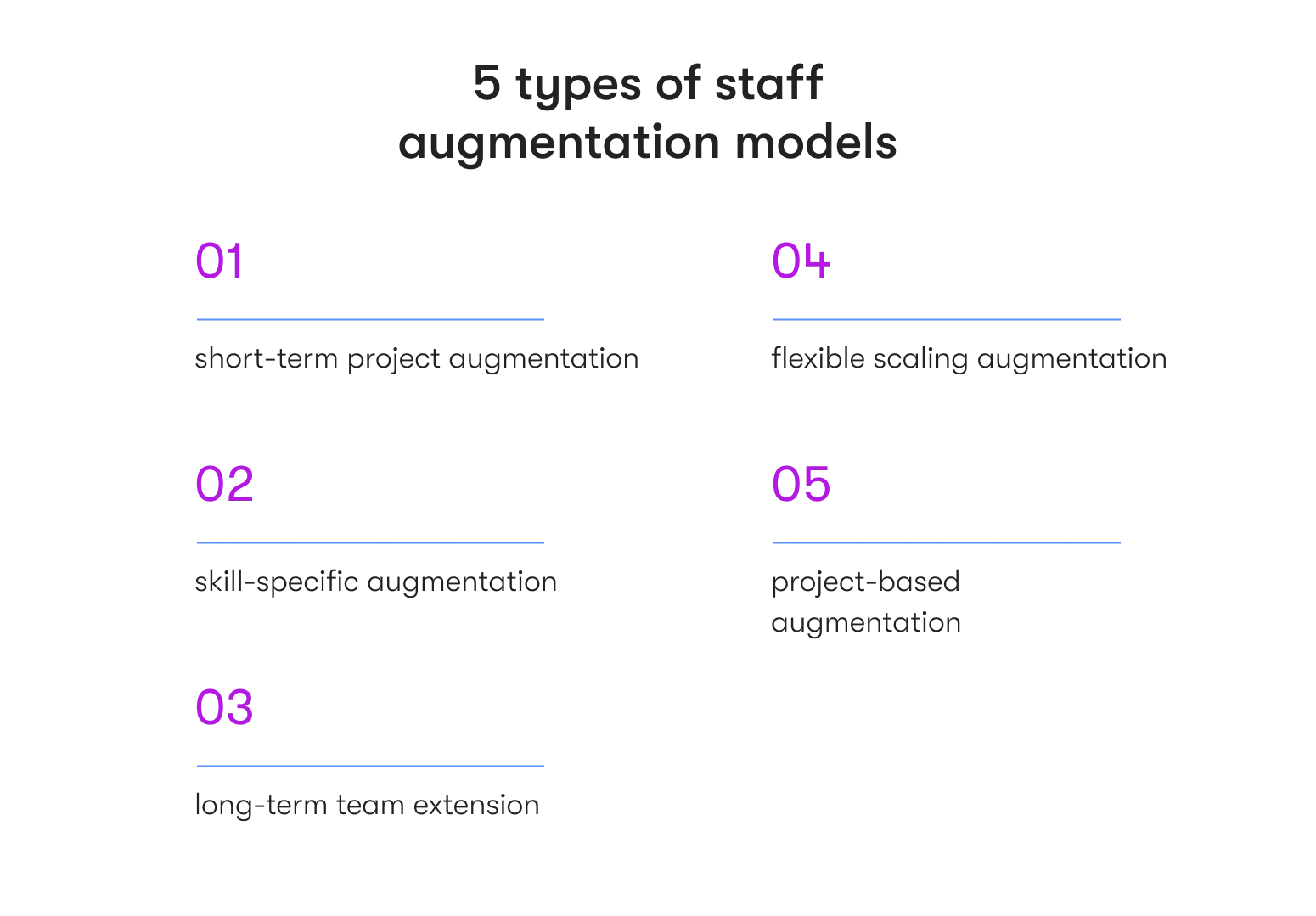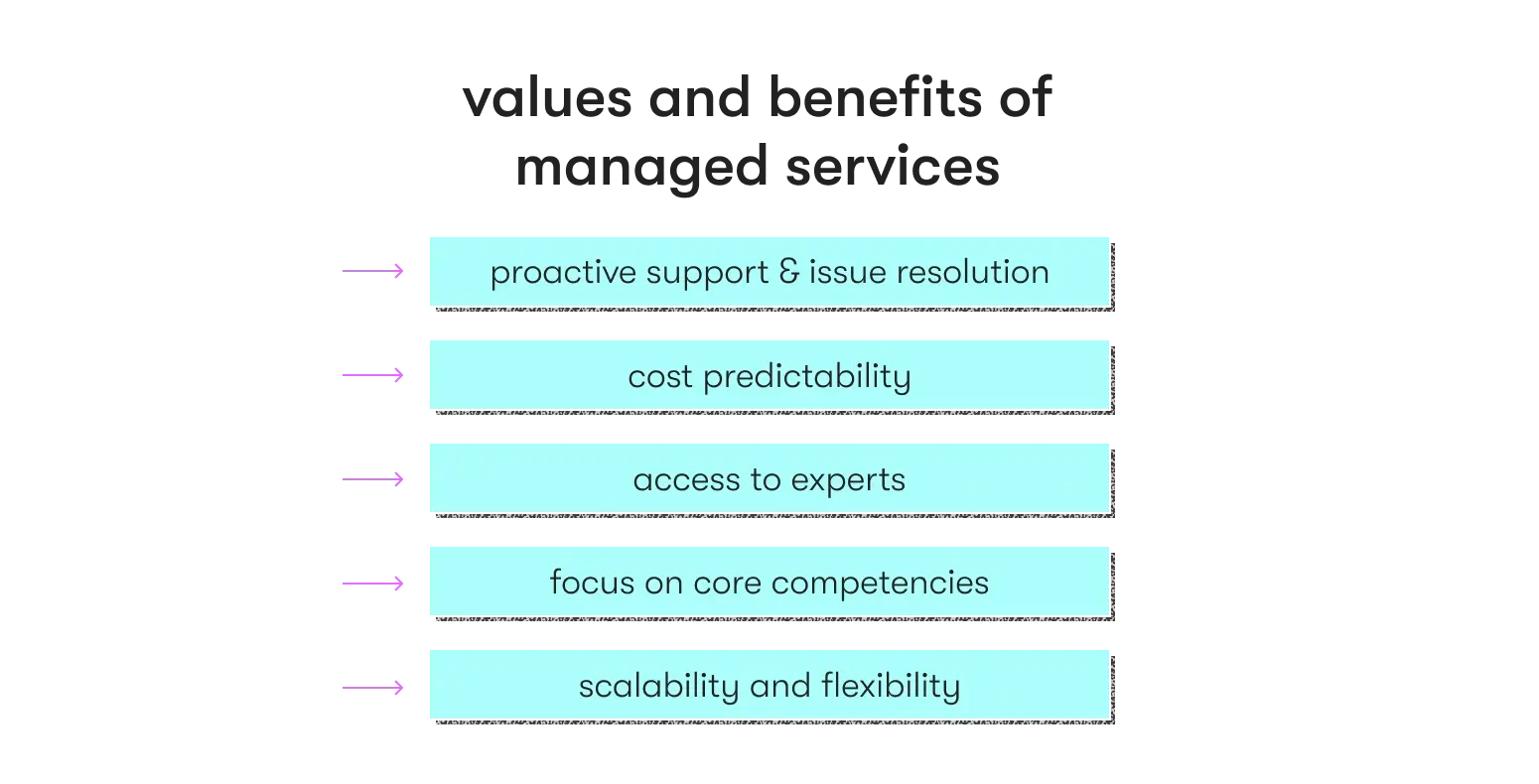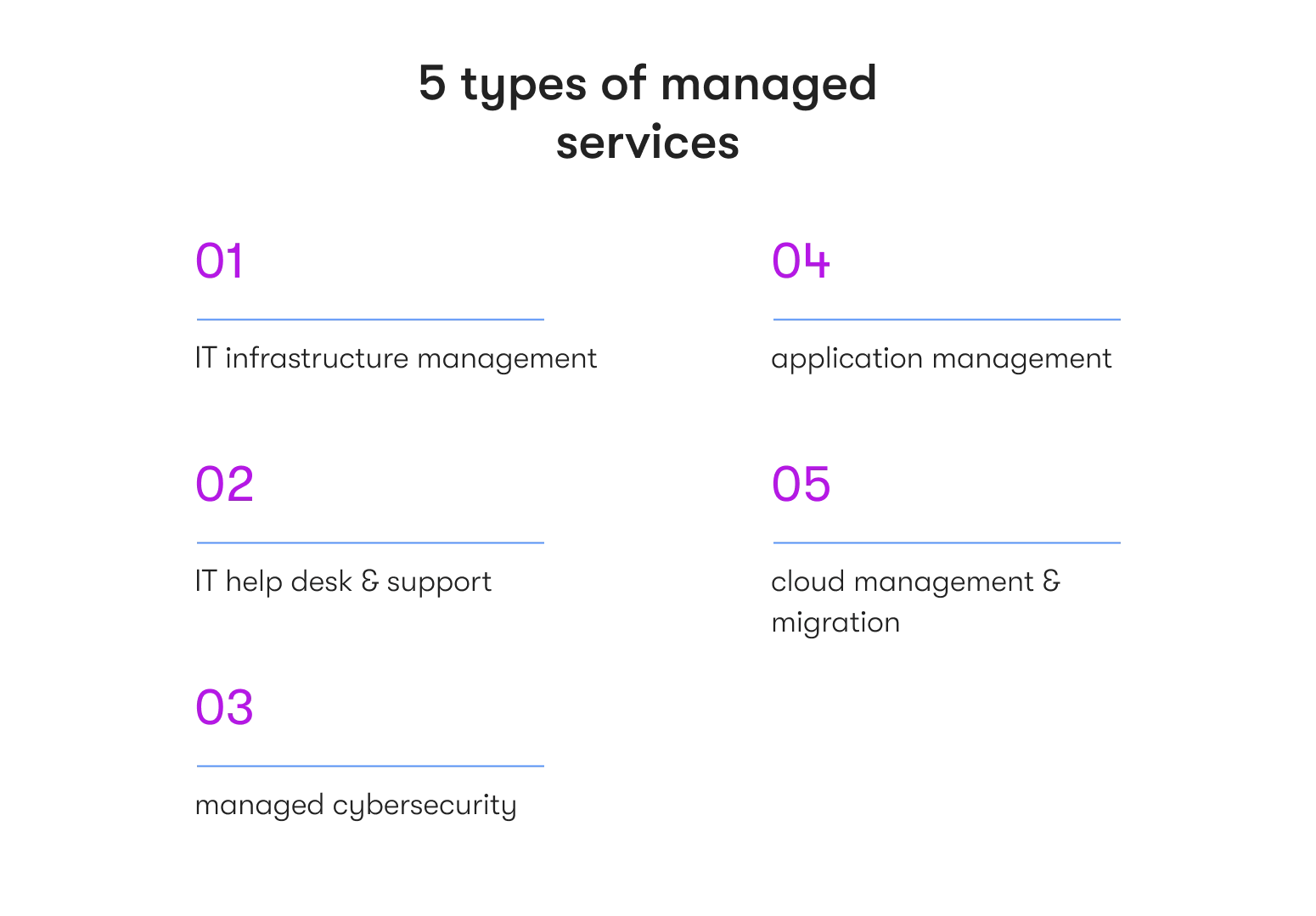In today's fast-paced and competitive business landscape, companies often face the challenge of balancing their software development needs with limited resources. As technology becomes increasingly integral to operations, the decision of whether to opt for staff augmentation or managed services becomes crucial.
Each approach offers unique advantages catering to specific business requirements. This article will explore the key differences between staff augmentation and managed services, helping you make an informed decision for your organization.
Staff augmentation: definition and what it can bring to your project
Staff augmentation services involve temporarily hiring external professionals to work alongside your existing development team. Augmented team members integrate into your company's operations, providing specialized skills and expertise to complement your in-house workforce.
This model promotes collaboration between your internal and external team members, fostering a cohesive working environment.
Here's a closer look at the key aspects of staff augmentation:

Flexibility and scalability
Staff augmentation offers the flexibility to scale your team up or down based on project demands. Whether you need additional resources for a specific project or want to address skill gaps, staff augmentation allows you to adjust your team size without the burden of long-term commitments.
Access to specialized skills
Augmentation firms provide professionals with specific expertise to address your project needs. This access to specialized talent can be especially valuable for projects requiring niche skills or the latest technologies.
Knowledge transfer and collaboration
Augmented team members can bring valuable knowledge and best practices to your organization. They work seamlessly with your in-house team, fostering collaboration and knowledge-sharing that can lead to enhanced project outcomes.
Reduced overheads
By hiring external professionals, you can avoid the administrative and HR overheads of hiring full-time employees. This saves time and effort and reduces costs associated with recruitment, training, and onboarding.
Improved productivity and time-to-market
Augmented teams can handle specific tasks or projects, allowing your core team to focus on essential initiatives. This streamlined approach often leads to improved productivity and faster time-to-market.
Cost-effectiveness
Staff augmentation can be a cost-effective way to meet your immediate project needs. You can access top talent without the financial commitment of hiring full-time employees, making it a suitable solution for startups and SMBs with limited budgets.
Staff augmentation models
Staff augmentation services offer various cooperation models that cater to different project needs and timelines. Understanding these models can help you choose the most suitable approach for your requirements.

Short-term project staff augmentation
This model is ideal for projects with defined scopes and specific timeframes. It involves hiring external professionals to work on the project for its entire duration, providing the necessary skills and expertise to achieve business goals. Once the project is completed, the augmented team members exit the organization.
Skill-specific staff augmentation
In this model, businesses hire professionals with specialized skills for specific tasks within a larger project. For example, if your project requires expertise in a particular programming language or technology, you can augment your team with professionals possessing those skills.
Long-term team extension
Long-term team extension involves the long-term hiring of external professionals to work with your in-house team. This model suits organizations that require consistent support and additional resources to meet their project demands.
Flexible scaling augmentation
Businesses with fluctuating project requirements can benefit from the flexible scaling model. It allows them to adjust the size of the augmented team based on the project's current needs, ensuring optimal resource utilization.
Project-based augmentation
This model involves hiring professionals to work on a specific project from inception to completion. The augmented team works collaboratively with your internal team throughout the project lifecycle.
DISCOVER A RANGE OF STAFF AUGMENTATION SERVICES
Discover the benefits and advantages of engaging staff augmentation services early on and cut down on costs while accelerating your project.
Managed services: understanding the value and benefits
Managed services involve the outsourcing of specific functions or tasks to an external managed service provider (MSP), who takes full responsibility for managing and delivering the services with a dedicated development team. This model suits businesses looking to offload specific responsibilities to expert service providers. Here's a deeper look at the benefits of managed services:

Proactive support and issue resolution
Service providers manage and maintain specific functions with managed IT services, for example AWS management. This proactive approach ensures quick issue resolution and minimizes downtime, contributing to smoother operations.
Cost predictability
Managed services often follow a subscription-based pricing model, providing cost predictability and ease of budgeting. This can be advantageous for businesses seeking to avoid unpredictable expenses.
Access to experts
Managed service providers often have an IT team of experts specializing in various domains. This allows you to tap into their knowledge and experience, benefiting from the latest industry best practices and innovations.
Focus on core competencies
Outsourcing non-core functions allows your internal team to concentrate on core competencies and strategic initiatives, driving business growth and innovation.
Scalability and flexibility
Managed service providers can scale their offerings to meet your evolving needs. Managed services can accommodate your requirements if you require additional support during peak periods or want to add new services.
Types of managed services
Managed services fall into a few major categories catering to business needs and service requirements. Understanding these types of services can help you identify the best fit for your organization. Here are some common types of managed services:

IT infrastructure management
This involves outsourcing the management and maintenance of your IT infrastructure to a managed service provider, typically within the DevOps-as-a-service offering. The provider handles server maintenance, network monitoring, security management, and data backup tasks.
Application management services (AMS)
The AMS model offers comprehensive support for managing your software apps throughout their lifecycle. It includes application maintenance and support, IT management, performance optimization, bug fixing, and regular updates.
IT support
Managed service providers can offer IT help desk and remote IT support, handle user inquiries, troubleshoot issues, and provide timely resolutions. This ensures that your employees and users can access expert support whenever needed.
Cloud management and migration
Cloud management and migration can be beneficial for businesses leveraging cloud technologies. Managed service providers can assist with cloud migration, optimize cloud resources, and ensure data security in the cloud environment.
Managed cybersecurity
This type focuses on outsourcing your organization's security operations to a managed cybersecurity service provider. The provider handles threat detection, vulnerability management, and incident response tasks, enhancing your overall cybersecurity posture.
FIND THE ENGAGEMENT MODEL THAT WORKS FOR YOU
Reach out to consult with our managers, who will propose a service model that works best for your business needs and objectives.
IT managed services vs staff augmentation: Determining the best fit for your organization
When deciding between staff augmentation and managed services, consider the specific requirements of your projects, the level of control you prefer, and the duration of support needed.
Staff augmentation is well-suited for short-term projects, skill-specific IT needs, and flexible scaling requirements. It offers collaboration with external professionals while maintaining control over project management.
On the other hand, managed services provide comprehensive support and expertise for ongoing tasks, allowing you to focus on core competencies while delegating specific responsibilities to a trusted service provider.
Staff augmentation and managed services offer distinct advantages for businesses seeking to meet their software development needs. Staff augmentation provides flexibility, specialized skills, and cost-effectiveness, while managed services offer comprehensive support, cost predictability, and expert access. Understanding the differences and benefits of each model is essential for making the right decision to drive success in your software development process. Consider your project requirements, internal capabilities, and long-term objectives to determine the best fit for your organization.
Staff augmentation and managed services are valuable solutions for businesses seeking to bolster their software development initiatives. By understanding the nuances of each model and evaluating your organization's needs, you can make a well-informed decision that aligns with your project objectives and overall business strategy. Partnering with an experienced and reputable service provider will be crucial for ensuring successful project outcomes and sustained growth in the competitive software development landscape. Whether you opt for staff augmentation or managed services, leveraging external expertise will undoubtedly enhance your organization's capacity to innovate and thrive in the dynamic world of technology.
Work with a vendor that puts you first
Our commitment to flexible scaling and fostering growth opportunities ensures your business can adapt seamlessly to changing demands. Operating in more than 400 locations worldwide, EPAM Startups & SMBs can swiftly identify and provide the right talent for your projects within a remarkable turnaround time of 4 weeks or even sooner.
Managed services vs staff augmentation: FAQ
Vendor engagement models such as staff augmentation and managed services refer to the different approaches and strategies that organizations use to delegate specific tasks or business processes to external service providers, often located in different countries.
Outsourcing can provide several advantages, such as cost savings, access to specialized skills, increased efficiency, and flexibility. It is important to educate yourself, especially when working with a vendor for the first time, to make sure you grasp all the nuances and understand which model works best for your project.
Some common questions you might have include:
What’s the difference between staff augmentation and managed services?
Staff augmentation, or staffing, refers to the hiring process and managing a workforce of external professionals. Managed services, on the other hand, involve outsourcing specific functions or tasks to an external IT service provider, who takes full responsibility for managing and delivering the services as per the contract.
What are staff augmentation services?
Staff augmentation services involve temporarily hiring external professionals to work alongside your existing team. Augmented team members integrate into your company's operations, providing specialized skills and expertise to complement your in-house workforce.
What’s the difference between staff augmentation and outsourcing?
While both staff augmentation and outsourcing involve hiring external resources, the key difference lies in the level of control and involvement. In staff augmentation, the external professionals work closely with you and contribute to internal processes, maintaining seamless collaboration. Outsourcing typically involves entrusting specific tasks or functions to an external provider without anyone directly integrating with your team.
What’s the difference between staff augmentation and consulting?
Staff augmentation focuses on providing additional resources and expertise to support your team's efforts in executing IT projects. Conversely, consulting involves seeking expert advice and guidance on specific issues or strategic decisions without providing additional workforce.
What are the benefits of hiring a staff augmentation firm?
There are four top benefits of hiring a staff augmentation team: access to specialized skills, scalability, faster time-to-market, and cost-effectiveness.
What are the advantages of staff augmentation?
Staff augmentation proves to be beneficial for a variety of reasons, especially when it comes to flexibility, knowledge transfer, reduced overheads, and improved productivity.
What are the benefits of staffing vs managed services?
The benefits of staffing include direct control and collaboration — you have complete control of the augmented team members who work seamlessly with your in-house team, fostering collaboration and knowledge-sharing. The benefits of managed services include proactive support and cost predictability.

Anush has a history of planning and executing digital communications strategies with a focus on technology partnerships, tech buying advice for small companies, and remote team collaboration insights. At EPAM Startups & SMBs, Anush works closely with subject matter experts to share first-hand expertise on making software engineering collaboration a success for all parties involved.
Anush has a history of planning and executing digital communications strategies with a focus on technology partnerships, tech buying advice for small companies, and remote team collaboration insights. At EPAM Startups & SMBs, Anush works closely with subject matter experts to share first-hand expertise on making software engineering collaboration a success for all parties involved.
Explore our Editorial Policy to learn more about our standards for content creation.
read more





















